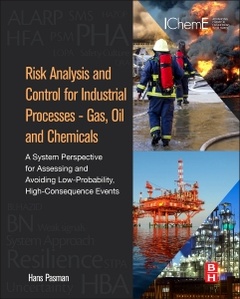Risk Analysis and Control for Industrial Processes - Gas, Oil and Chemicals A System Perspective for Assessing and Avoiding Low-Probability, High-Consequence Events
Auteur : Pasman Hans J

Risk Analysis and Control for Industrial Processes - Gas, Oil and Chemicalsprovides an analysis of current approaches for preventing disasters, and gives readers an overview on which methods to adopt.
The book covers safety regulations, history and trends, industrial disasters, safety problems, safety tools, and capital and operational costs versus the benefits of safety, all supporting project decision processes.
Tools covered include present day array of risk assessment, tools including HAZOP, LOPA and ORA, but also new approaches such as System-Theoretic Process Analysis (STPA), Blended HAZID, applications of Bayesian data analytics, Bayesian networks, and others. The text is supported by valuable examples to help the reader achieve a greater understanding on how to perform safety analysis, identify potential issues, and predict the likelihood they may appear.
Professor Pasman graduated in Chemical Technology at Delft University of Technology in 1961, and finished a Doctor’s thesis in 1964 while working for Shell. He joined the Dutch Organisation for Applied Research, TNO, in 1965, initiating and performing research in reactive materials, gas, dust and energetic material explosions, investigation of industrial accidents and risk analysis, while also managing organizational units.
He has been a member of the Working Party on Loss Prevention and Safety Promotion in the Process Industries since 1972, and chairman from 1986-2004. In this latter capacity he was instrumental in founding the European Process Safety Centre in 1992. He has also been chairman of the International Group on Unstable Substances (IGUS) for 10 years, of the European Study Group on Risk Analysis (1980-1985), and of a NATO Group on Explosives (1982-1992). At the Delft University of Technology he led a multinational project on gas explosion fundamentals at elevated pressures and temperatures (2003-2008). In 2007 he co-organized a NATO advanced research workshop on Resilience of Cities to Terrorists and other Threats. From 2004-2012 he was a Member of the Dutch national Advisory Council on Hazardous Substances.
- Presents new methods on how to identify hazards of low probability/high consequence events
- Contains information on how to develop and install safeguards against such events, with guidance on how to quantify risk and its uncertainty, and how to make economic and societal decisions about risk
- Demonstrates key concepts through the use of examples and relevant case studies
Date de parution : 06-2015
Ouvrage de 458 p.
19x23.3 cm
Thème de Risk Analysis and Control for Industrial Processes -... :
Mots-clés :
Abnormal situation management; Accident causation; Accountability; Alarm management; ALARP; Bayesian network applications; Blended hazard identification; BLEVE; Bow-tie; Control room; Cost-benefit of risk measures; Costs of accidents; Costs of safety; Decision analysis; Deep uncertainty; Deepwater Horizon demise; Detonation; Dispersion models; Dynamic risk analysis; Educational methods; Explosion types; Fault detection and diagnosis; Fukushima nuclear power plant disaster; Fuzzy set; Goal-oriented regulation; Hazard classification; Hazard potential; Hazardous materials; Hazardous properties; Hazardous substance properties; HazOp; Human error; Human factor; Human reliability; Industrial process accidents; Industry trends; Inherent safety; Inspection; Knowledge management; Land use planning; LOPA; Loss prevention; Major industrial hazards; Model predictive control; Occupational risk; Offshore safety; Organizational and technical resilience; Performance-based law; Prescriptive ruling; Probabilistic methods; Process control; Process safety in curricula; Process safety knowledge; Process safety performance indicators; Regulation types; Regulatory risk control; Resilience engineering; Retour d'expériences; Risk; Risk acceptance; Risk and culture; Risk assessment; Risk communication; Risk governance; Risk management; Risk perception; Risk tolerability; Risk tolerance; Risk-based economic decision making; Runaway; Safety attitude; Safety culture; Safety education; Safety management; Safety regulation; Site inspection issues; Situation awareness; Societal change; Sociotechnical system; Stationary source siting; System ergonomics; System-theoretic process analysis; Systemic safety analysis; Training simulators; Transportation risks; Uncertainty; Utility theory; Vapor cloud explosion



